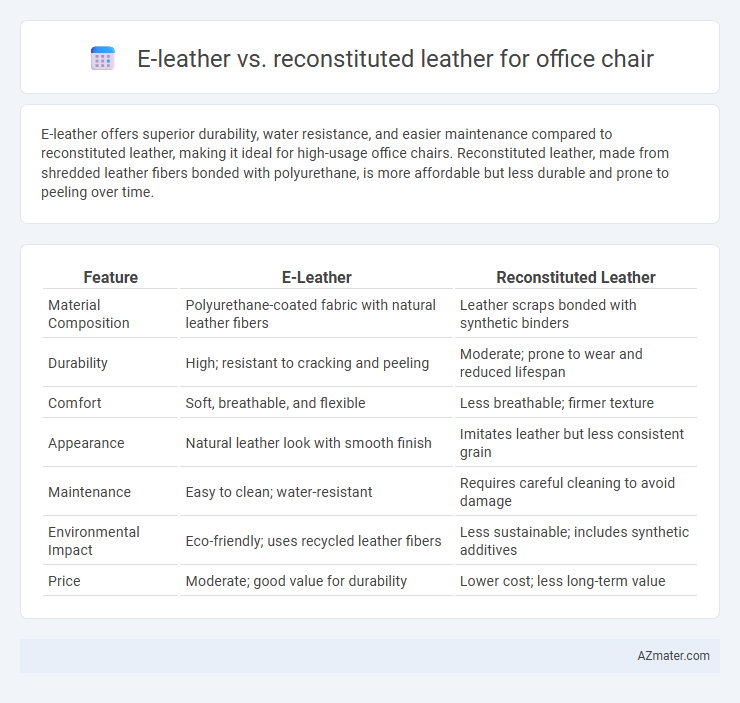E-leather offers superior durability, water resistance, and easier maintenance compared to reconstituted leather, making it ideal for high-usage office chairs. Reconstituted leather, made from shredded leather fibers bonded with polyurethane, is more affordable but less durable and prone to peeling over time.
Table of Comparison
| Feature | E-Leather | Reconstituted Leather |
|---|---|---|
| Material Composition | Polyurethane-coated fabric with natural leather fibers | Leather scraps bonded with synthetic binders |
| Durability | High; resistant to cracking and peeling | Moderate; prone to wear and reduced lifespan |
| Comfort | Soft, breathable, and flexible | Less breathable; firmer texture |
| Appearance | Natural leather look with smooth finish | Imitates leather but less consistent grain |
| Maintenance | Easy to clean; water-resistant | Requires careful cleaning to avoid damage |
| Environmental Impact | Eco-friendly; uses recycled leather fibers | Less sustainable; includes synthetic additives |
| Price | Moderate; good value for durability | Lower cost; less long-term value |
Understanding E-Leather: Composition and Properties
E-leather, or engineered leather, combines natural leather fibers with polyurethane to create a durable, flexible material that mimics genuine leather's texture and appearance. Its breathable and water-resistant properties make it an ideal choice for office chairs, ensuring comfort and easy maintenance throughout long work hours. Compared to reconstituted leather, E-leather offers enhanced wear resistance and a more consistent finish, contributing to both aesthetic appeal and longevity in office environments.
What Is Reconstituted Leather? Key Features and Process
Reconstituted leather, also known as bonded leather, is manufactured by shredding genuine leather scraps and fibers, then binding them together with polyurethane or latex on a fiber or paper backing. This material offers a cost-effective and eco-friendly alternative to traditional leather, providing a leather-like appearance with increased uniformity and less ethical concerns. Key features include durability, flexibility, and improved resistance to cracking, making it a practical choice for office chair upholstery without compromising on comfort or style.
Durability Comparison: E-Leather vs Reconstituted Leather
E-leather, often crafted with synthetic fibers and polyurethane coating, offers superior durability and resistance to wear, making it ideal for high-use office chairs. Reconstituted leather, made from shredded leather fibers bonded with adhesives, tends to be less durable and prone to cracking over time under constant use. Choosing e-leather enhances office chair longevity, reducing maintenance costs and ensuring consistent performance in demanding environments.
Comfort Levels: Which Leather Is Best for Office Chairs?
E-leather offers superior breathability and softness, providing enhanced comfort for long hours in office chairs by mimicking natural leather's texture. Reconstituted leather, made from shredded leather fibers bonded with polyurethane, tends to be denser and less flexible, which can cause discomfort during extended use. Prioritizing comfort in office chairs, E-leather stands out due to its lightweight feel, durability, and ability to regulate temperature better than reconstituted leather.
Maintenance and Cleaning Requirements
E-leather for office chairs offers superior resistance to stains and requires minimal maintenance, needing only regular wiping with a damp cloth and occasional use of a mild soap solution. Reconstituted leather demands more frequent cleaning to prevent cracking and peeling, including gentle conditioning treatments to maintain its integrity and appearance. Both materials benefit from prompt spill cleanup, but e-leather's durable surface significantly simplifies long-term upkeep and reduces the risk of damage from everyday office use.
Eco-Friendliness and Sustainability Factors
E-leather, often made from polyurethane with synthetic fibers, offers durability but may involve higher environmental costs due to petrochemical-based materials and limited biodegradability. Reconstituted leather, produced by binding leather scraps with adhesives, reduces waste by repurposing offcuts and has a lower carbon footprint, enhancing sustainability in office chair manufacturing. When prioritizing eco-friendliness, reconstituted leather supports circular economy principles more effectively than conventional E-leather options.
Aesthetic Appeal and Customization Options
E-leather offers a sleek, modern aesthetic with a smooth surface that mimics genuine leather, making office chairs visually appealing and easy to clean. Reconstituted leather provides a textured, natural look created from leather fibers bonded with polyurethane, allowing for more diverse patterns and finishes that enhance customization. Both materials enable tailored designs, but reconstituted leather excels in offering varied tactile experiences suitable for unique office environments.
Cost Analysis: E-Leather vs Reconstituted Leather
E-leather typically offers a higher upfront cost compared to reconstituted leather due to advanced manufacturing processes and improved durability, making it a more premium choice for office chairs. Reconstituted leather, often made from shredded leather fibers bonded with polyurethane, is more budget-friendly but may require more frequent replacements, increasing long-term expenses. When analyzing total cost of ownership, e-leather's superior lifespan and maintenance ease can offset initial expenses, delivering better value in office chair investments.
Common Applications in Modern Office Chairs
E-leather, a synthetic material made from polyurethane coatings on a fabric base, is commonly used in modern office chairs for its durability, easy maintenance, and leather-like appearance. Reconstituted leather, crafted from shredded leather fibers bonded with adhesives, offers a more sustainable option with similar aesthetics but lower cost and less breathability. Both materials are favored in office chair production for combining affordability with style, although e-leather is more popular in high-traffic environments due to its enhanced resistance to wear and stains.
Choosing the Right Material for Your Office Needs
E-leather, made from polyurethane bonded to fabric, offers durability and easy maintenance, making it ideal for high-traffic office chairs requiring frequent cleaning. Reconstituted leather, composed of shredded leather fibers combined with polyurethane, provides a genuine leather look at a lower cost but may lack the same longevity and breathability. Selecting E-leather ensures resistance to stains and consistent texture, while reconstituted leather suits budget-conscious buyers seeking aesthetics over extended wear.

Infographic: E-leather vs Reconstituted leather for Office chair
 azmater.com
azmater.com